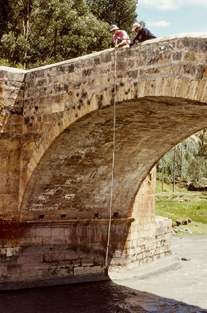 The burning
of fossil fuels, which releases carbon dioxide into the atmosphere, and the
implications for global climate have thrown a spotlight on the carbon cycle,
including where carbon is stored and for how long. Scientists have long puzzled
over whether rainforests of the Amazon might continually increase capacity for
long-term carbon storage, or a “carbon sink,” to combat greenhouse
gas warming. New research indicates, however, that much of the new carbon entering
the forests rapidly leaks out via rivers and back into the atmosphere.
The burning
of fossil fuels, which releases carbon dioxide into the atmosphere, and the
implications for global climate have thrown a spotlight on the carbon cycle,
including where carbon is stored and for how long. Scientists have long puzzled
over whether rainforests of the Amazon might continually increase capacity for
long-term carbon storage, or a “carbon sink,” to combat greenhouse
gas warming. New research indicates, however, that much of the new carbon entering
the forests rapidly leaks out via rivers and back into the atmosphere.Researchers collected water from rivers in the Amazon basin to date the carbon suspended or dissolved in the water. They recently found that carbon moves from the atmosphere, through trees, soil and water, and back into the atmosphere in fewer than five years, indicating that the landscape is not providing as much long-term storage of carbon dioxide as hoped. Image courtesy of Stroud Water Research Center.
Previous research dated carbon that was reaching the oceans through the Amazonian rivers and found it to be decades to centuries old, says Anthony Aufdenkampe, a biogeochemist at the Stroud Water Research Center in Avondale, Pa. Therefore, researchers had hoped that carbon might be locked up in these river systems that long, therefore providing some balancing mechanism for human-made emissions of carbon dioxide. No one, however, had dated the actual carbon dioxide leaving the river system to test that idea.
So, Aufdenkampe and colleagues extracted and dated carbon dioxide from water sampled from rivers and wetlands in the Amazon basin. They also collected and dated organic carbon detritus, such as leaves and twigs, as well as fine particulate matter. While they dated most of the organic carbon as decades to centuries old, the carbon dioxide itself was fewer than five years old, Aufdenkampe says.
The scientists also found that rivers in the enormous Amazon basin are saturated with five to 30 times more carbon dioxide than they would be at equilibrium with the atmsophere. As reported by Emilio Mayorga, Aufdenkampe and colleagues in the July 28 Nature, the rivers expunge the carbon dioxide as quickly as possible to get back to equilibrium, so they exhale the gas into the atmosphere rapidly — much more rapidly than researchers expected.
Because the rivers are cycling forest carbon back into the atmosphere in fewer than five years, mature rainforests are not as large a sink for the greenhouse gas as researchers had hoped, Aufdenkampe says. Their work suggests that trees in the rainforest canopy suck up carbon dioxide and drop the carbon (in the form of leaves or twigs) onto the ground and into rivers and wetlands. Riverine creatures, including bacteria, insects and fish, chew up nearly all the terrestrial carbon reaching the river, and subsequently release carbon dioxide into the water, which then exhales it back into the atmosphere, completing the cycle.
The Amazon River system could thus be outgasing as much as 1 gigaton of carbon a year, Aufdenkampe says, nearly equal to the amount of carbon dioxide released by global deforestation. With as much carbon released as is taken up by the forests, the researchers suggest that the Amazon basin thus “has no net effect on greenhouse gas concentrations in the atmosphere,” he says. One concern, however, is that increased deforestation or accelerated climate change might release old carbon previously stored in the forests, which could make the region a net source of greenhouse gasses.
This “hugely significant research” brings researchers closer to finding the missing carbon sink, which could be elsewhere in the river system, says Rolf Aalto of the University of Washington in Seattle, who was not involved in this research. “People have long thought of rivers as sewer pipes, just carrying stuff from the land to the sea,” he says. This research, however, “shows that the rivers are actually doing a lot more in between — this ‘sewer system’ is actually overflowing and distributing carbon” throughout the landscape. The paper, Aalto says, “provides an exciting framework for our understanding of the entire system.”
Indeed, wrote Peter Raymond of Yale University in an accompanying paper in Nature, future studies of the role of streams and rivers in the carbon budget can use this research as a jumping-off point. “Research should now focus on how land use and climate change have altered the timescales of the connections between the atmosphere, land and water reported by Mayorga et al.,” Raymond wrote. Understanding where carbon is coming from and how old it is, he wrote, is important for figuring out the effects of the burning of fossil fuels on the global climate and economy.

